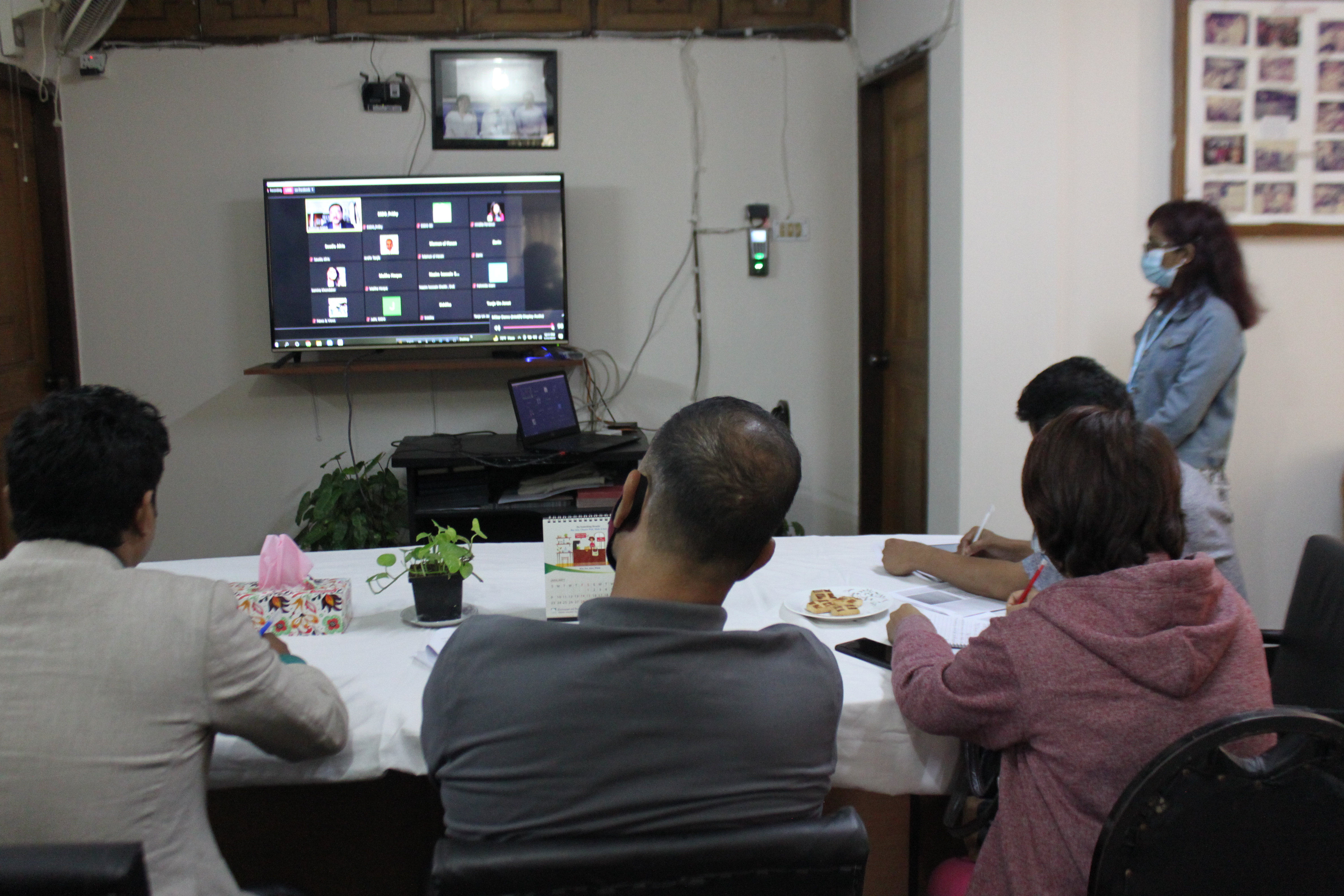Environmental Groups Call for International Action to Control Plastic Chemicals!

New worldwide research reveals that there are health risks across the plastics production chain
Dhaka 13th January 2022: Environmental activists and experts demanded an international response to prevent toxic in plastic. This demand was made on a media briefing on ‘Chemicals in Plastic: A Growing Public Health Crisis’ organized by Environment and Social Development Organization – ESDO in collaboration with International Pollutants Elimination Network – IPEN on 13th January both physically and virtually.
Throughout their entire life cycles, plastics pose a significant hazard to human health and ecosystems. IPEN collaborated with International Pellet Watch (IPW) and its NGOs partners in 35 countries, including Bangladesh. During the assessment hazardous chemicals and pollutants were present in spilled or lost pre-production plastic pellets found on beaches and recycled plastic pellets purchased from recycling facilities.
Both studies reveal the presence of toxic chemical additives and pollutants that pose multiple health threats to humans and the environment. The health effects include causing cancer or changing hormone activity (known as endocrine disruption), which can lead to reproductive, growth, and cognitive impairment. Many of the toxic chemical additives have several other known health impacts, persist in the environment, and bioaccumulate in exposed organisms.
The study was done on a total number of 18 compounds which include 11 brominated flame retardants, 6 UV-stabilizers, and bisphenol A. 12 of the 18 substances are recognized to be endocrine disruptors (EDCs).
When the pellets include brominated flame retardants, it means that polymers from electronic trash were included in the material that was recycled. When the pellets include bisphenol A, it means there is a possibility that polycarbonate plastics were used in the recycling process. It’s not a good idea to combine these polymers.
ESDO study and Bangladesh results:
All three classes of chemicals examined were present in the pellets that are ordered. There were four compounds in them: one flame retardant, two UV stabilizers, and bisphenol-A. There were two endocrine-disrupting substances discovered in your samples. These pellets are inappropriate for use in new goods due to their chemical contamination.
ESDO’s Secretary-General, and one of the authors of the beach pellet study, Dr. Shahriar Hossain says: “These latest findings support our argument that international action to promote more sustainable plastics uses must go beyond waste management to address the harm and damage caused by harmful chemical additions in plastics.” He also mentioned the impacts of different chemicals and said “Brominated flame retardants (BPA) have gained the most attention, and accumulate in tissue, cause cancer, change hormones, impair the reproductive system, and cause neurodevelopmental disorders in animals and maybe humans. He also emphasized the dangers of Endocrine-Disrupting Chemicals (EDCs) present in children’s toys, as well as how they cause neurobehavioral issues in kids.
International action pending
In February 2022, countries will meet at the United Nations Environment Assembly to discuss a global instrument on plastics, largely focused on waste and marine litter. IPEN says the new studies indicate that plastics present much greater threats, especially to low- and middle-income countries that are not primarily responsible for plastics production or consumption and do not have the capacity to manage the risks associated with toxic chemicals. These threats need to be dealt with at the international level.
It is estimated (Wiesinger et al. 2021) that over 10,000 chemicals are present in plastics; around 5,000 of these are chemical additives that contribute to the function of products. Many of these chemicals are toxic, yet only a few are subject to regulatory control. In fact, regulatory information on the safety of many chemical additives is incomplete, and little is known about the risks of exposure to the complex mixtures of toxic pollutants currently being transported in and released from plastic pellets.
The chemicals assessed in the beach pellets study included ten ultraviolet (UV) stabilizers and 13 polychlorinated biphenyls (PCBs). The recycled pellets study assessed 11 flame retardants; bisphenol A; and six UV light stabilizers.
The international community has already taken some steps against plastics, primarily focusing on waste. But IPEN and IPW say all phases of plastics manufacture, transport, use, recycling, and disposal need to be addressed and regulators need to be more aware of the threats to health and ecosystems posed by the thousands of toxic chemical additives used in plastics.
ESDO and IPEN are calling for an international plastics treaty to:
- Ban the use of toxic chemical additives in plastics, identify essential uses of plastics, scale down all other production and phase out all non-circular plastics;
- Apply extended producer responsibility programs to ensure industry bears the costs of plastics throughout their life cycle;
- Require essential uses of plastics to be designed for durability and reuse;
- Ensure end-of-life treatment of plastics waste does not release toxic chemicals, litter, or contribute to climate change, and ban waste export and incineration; and
- Include funding for implementation and monitoring.
In the meantime, as the chemical and plastic industries do not disclose what is in their products throughout the supply chain, greater transparency on toxic chemical additives used in plastics is needed, along with data on the quantities of plastics made, traded, and disposed of. It should be noted that the studies only reveal some of the toxic chemicals in plastics.
###
IPEN (International Pollutants Elimination Network) is a global environmental network of over 600 public interest NGOs in 128 countries, working to eliminate and reduce the most hazardous substances to forge a toxics-free future for all. IPEN is registered in Sweden as a public interest non-profit organization. www.ipen.org
International Pellet Watch is a nonprofit ecotoxicological research group that monitors persistent organic pollutants (POPs), plastic waste, and plastic pellets around the world. Based at Tokyo University of Agriculture and Technology, Laboratory of Organic Geochemistry in Tokyo. http://pelletwatch.org/
Background information
Environment and Social Development Organization- ESDO
ESDO is successfully running community mobilizing and awareness-raising campaigns. We initiated the “Anti-polythene/plastic Campaign” in 1990, which resulted in a complete ban of polythene shopping bags throughout Bangladesh. Following this, ESDO is working relentlessly to ensure biological diversity since its formation in 1990. It is the pioneer organization that initiated the anti-polythene campaign in 1990 which later resulted in a complete ban of polythene shopping bags throughout Bangladesh in 2002. From then after continuous advocacy of ESDO, the High Court of Bangladesh has ordered the concerned authorities to phase out Single-use plastic products within 31 December 2022 from the coastal area. ESDO has done some tremendous work regarding the single-use plastic products ban.
Beach pellet study
The first study found beached pellets at 22 test locations, including sites in Africa, North and South America, Asia, Australia, the Caribbean, and Europe. The samples were analyzed by Ms. Mona Alidoust and colleagues at the Tokyo University of Agriculture and Technology, led by Professor Hideshige Takada.
Chemicals assessed included:
- UV Stabilizers Ten benzotriazole UV (BUV) light stabilizers, which are intentionally added to plastics to prevent degradation by sunlight. Several are regulated in the EU and one, UV-328, is being recommended for a global ban through addition to the Stockholm Convention on Persistent Organic Pollutants (POPs); and
- PCBs Pollutants known as PCBs (polychlorinated biphenyls), were banned under the Stockholm Convention in 2001, but because of their widespread use, are still found in the environment. IPEN examined the role of beached plastic pellets in absorbing and transporting 13 different PCB compounds in the environment.
The researchers found that all samples from all locations contained all ten BUVs and all 13 PCBs included in the study. Half of the locations had samples with PCB levels that were highly or extremely polluted.
Of the beach pellet study, Professor Hideshige Takada says: “The study demonstrates how the plastics industry causes problems even before products enter the marketplace and reach the consumer. By acting as a vector for toxic chemical additives like BUVs, and existing toxic chemicals,like PCBs, pre-production plastic pellets threaten the health and the environment.”
Recycled pellet study
The second study assessed toxic chemical additives in recycled high-density polyethylene (HDPE), which is one of the most used and recycled plastics today. IPEN’s NGO partners bought bags of HDPE pellets from 24 recycling companies in 23 countries (two samples were bought in different cities in India) across Africa, Latin America, Asia, and Europe.
Toxic chemical additives assessed included:
- Flame Retardants 11 flame retardants, including polybrominated diphenylethers (deca-, octa- and penta-BDE), hexabromocyclododecane (HBCD) and tetrabromobisphenol A (TBBPA), and newer, replacement brominated flame retardants including 1,2-bis(2,4,6-tribromophenoxy) ethane (BTBPE) and octabromo-1,3,3-trimethylphenyl-1-indan (OBIND);
- Bisphenol A; and
- UV Light Stabilizers Six benzotriazole ultra-violet stabilizers (BUVs), including UV-327, UV-328, and UV-P.
The samples were analyzed at the University of Chemistry and Technology Prague in the Czech Republic. All of the samples contained at least one type of toxic chemical additive and 21 samples contained additives from each of the three groups tested. Only one sample, from Vietnam, contained just a single type of contaminant. Over half of the samples contained 11 or more of the 18 toxic chemical additives analyzed.
For more information please contact:
Subhatun Nur Prithy
Project Associate-ESDO
Email: info@esdo.org
Mobile: +8801726053420


